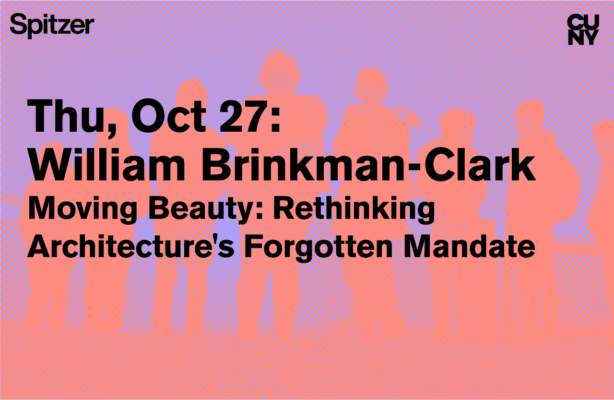News
Fall 2022 Sciame Lecture Series: William Brinkman-Clark
This lecture was held on 10/27/22 and was part of the Spitzer Fall 2022 Sciame Lecture Series, titled “Border Crossings: Architecture and Migration in the Americas.”
William Brinkman-Clark is a professor at the Universidad Nacional Autónoma de México. His research focuses on the cosmetic relation between the aesthetic and the politic as it regards public space and Architecture. He has written various articles for Historia y Grafía, Cuadernos de Vivienda y Urbanismo, Theorein and Bitácora Arquitectura. In 2019 he published Ciudad:Tragedia, an exploration of the unavoidably tragic nature of all modern practices of architectural and urban design. His forthcoming book, Antígona Plástica, explores the way aesthetic categories of rigidity and uprightness have manifested and entrenched themselves in western notions of class and gender, and how the concept of plasticity can be an instrument that can not only help us in understanding the resilience of traditional societal structuring, but also in their dismantlement.
Throughout late-modernity, Architecture has progressively relied on scientific and technological knowledge as a means to justify itself and its projects. With some notable exceptions, aesthetic considerations have been relegated to a secondary or complementary role. Beauty in Architecture has become something that can be considered only if Reason has first solved its socio-economical requirements; and even then, we tend to frame the quest for Beauty as superficial, capricious, and banal.
Throughout Western Culture, Beauty has had an unrelinquishable part in the construction of any World deemed worthy of chasing. Architecture holds a special responsibility in these Ethics: the Vitruvian Triad does not give us a choice on whether we should incorporate Beauty into our design of the habitable world; it mandates Stability, Utility,and Beauty.
In the relation between Architecture and Migration, this forgotten mandate becomes apparent. Solving problems such as — among others — housing for the displaced or shelter for those in movement in a functional and economical manner is, of course, indispensable. However, Architecture must remember that Beauty it is one of the main forces that jumpstarts human movement. Aristotle speculated that only a beautiful image can move us in the direction of what is fair and just. Has that really changed? If not, Architecture must not only reconsider the importance of Beauty, it must also question who determines what is Beautiful: are we to continue pretending a few can dictate what Beauty is, or are we to open our eyes to what really moves people; to Democratic Beauty?


